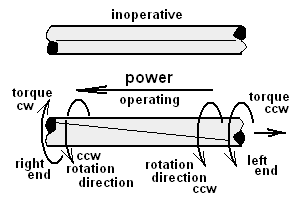| THERMO Spoken Here! ~ J. Pohl © | TOC NEXT ~ 178 |
3.25 Energy Rates and Power
The principles of thermodynamics can be expressed in either of three distinct mathematical formats. The differential format is used to develop equations and for derivation of special results. Time is not a factor with differential considerations.
Time is applied in increment format equations to mark the states of its "start" then later "stop." The third equation format is the rate form. The increment format energy equation we have been using is:

| (1) 1 |
Equation formats are not independent, being simply expressions of physicality from three vantages of time, each can be manipulated into either of the other two perspectives. There being three forms, hopefully you are thinking, is there one that is superior? If so, Why?
When Newton wrote his Laws of Motion he was well acquainted with mathematics and mathematical forms. For his Laws of Motion he chose rate format.
Physical equations of the rate format are differential equations with time as the independent variable.
This increment form is obtained by integration of a rate form between limits in time. The rate form energy equation is first order differential equation.

| (2) 2 |
A very important term is missing from the above equation. Many systems have energy delivered to them in a rate fashion by a mechanical shaft.
SHAFT WORK: That work passes through shafts of machines is obvious. Yet a thermodynamic discussion is worthwhile. Consider a machine that has a power shaft but which is off, inoperative.

While the shaft is inoperative (not rotating) press a sharp-edged bar of steel against the shaft and pull it from one end to the other thereby leaving a scribed line the length of the shaft (shown as "inoperative").
Later, when the machine is running with a load, we position a variable frequency flashing light called a strobe light beside the shaft and adjust it to flash each precise instant the scratched line can be seen from beside the shaft. With good, expensive equipment it can be seen that the shaft, while power passes through it, is twisted. (shown as "operating").
Work enters the shaft at the right end. The torque is clockwise there and so is the rotational direction. At the left end, by the observed twist of the shaft, the torque is seen to be counter-clockwise while the shaft rotates clockwise. Thus work enters at the left end exits at the left. The expression for shaft work (a rate) is:

| (3) 3 |
If the shaft drives truck wheels that are stuck in mud, the wheels might have traction, slip, then have traction again in a repeated way. Loads on the shaft with such behavior might increase the internal energy of the shaft (and its temperature) to the point the shaft breaks (shears).
Thus having recognized shaft work, the rate form energy is written as:

| (4) 4 |
The reminder of this section presents instances of physical reality that occur in a rate manner. The situations are repetitive; they do not "build" one on the other.
3.25 Energy Rates and Power
The principles of thermodynamics can be expressed in either of three distinct mathematical formats. The differential format is used to develop equations and for derivation of special results. Time is not a factor with differential considerations.